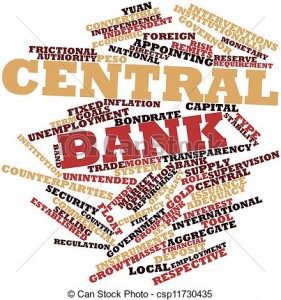FUNCTIONS OF CENTRAL BANK
The Central Bank performs the following important functions:
- Issue of Currency Authority. The Central Bank is the sole authority for the issue of currency in the country. Notes issued by it are circulated as legal tender money. It has its issue department which issue notes and coins. Coins are manufactured in the government mint but they are put into circulation through the central bank. While issuing currency notes, a minimum field amount of gold and foreign currencies is kept by the central bank. By having a monopoly of note issue, it can restrict or expand the supply of cash according to the requirements of the economy.
- Banker to the government. The Central Bank acts as a banker to the government in various respects:
- The Central Bank accepts receipts and make payments for the governments and carries out exchange, remittance and other banking operations.
- It provides short-term credit to the government.
- It provides foreign exchange resources to the government to repay external debt.
- It manages public debt, i.e., to manage all new issues to government loans.
- It advises the government on banking and financial matters.
- Banker’s Bank and Supervisor. The Central Bank acts as a banker and supervision to commercial banks in various respects :
- It provides financial assistance to banks by discounting their bills and through loans and advances against approved securities.
- The commercial banks are required to maintain a certain percentage of liabilities with the Central Bank. The sole aim of these reserves is to enable the Central Bank to provide financial assistance in times of financial emergency.
- It supervises, regulates and control the activities of commercial banks.
- It provides the commercial banks with centralized clearing and remittance facility.
- The Central Bank performs the function of controller of credit. For this purpose it adopts quantitative and qualitative methods of credit control.
- Lender of the last resort. The Central Bank acts as a lender of the last resort for commercial banks. When commercial banks fails to meet obligations of their depositors, The Central Bank comes to their rescue. It advances necessary credit against eligible securities subject to certain terms and conditions. This saves bank from a possible breakdown. Prof. Sayers regards this function of the central bank as the basic important function of Central Banking System.
Click here for government certification in Accounting, Banking & Finance





19 Comments. Leave new
Very informative.
very good..
great efforts…the central bank also intervenes sometimes to control inflation in the nation..
Informative
Nice.Well compiled!
Nicely written;:)
very informative!!
Good article. Every citizen should know this.
informative 🙂
presented is a very nice manner!
good articulation!!
Central Bank plays a vital role in an economy.
Good job done.
Good explanation.
well described!
Well elaborated
Informative and well articulated
this is something, every citizen of India should know about!And this is going to be realized through Financial Literacy program!
Nicely presented..!
nicely done.